Test – AMD R9 295 X2 | Specs | Pric – Back at AMD today with a card that is still the brand’s most powerful card today, I named the R9 295 X2! Despite the relative old age of the card, it is still one of the most powerful cards on the market, equipped with 2 “Hawaii” GPUs perfectly identical to the R9 290X AMD has not cut corners with this card, see instead:
| Menu | GPU | Transistors (in billions) | ROPs | Calculation units | GPU Frequency / Memory | Memory Capacity | Bus |
|---|---|---|---|---|---|---|---|
| R9 295X | 2x Hawaii | 2 x 6.2 | 2 x 64 | 2 x 2816 | 1018/1250 | 2 x 4 GB | 512 bits |
| R9 390X | Grenada | 6.2 | 64 | 2816 | 1050/1500 | 8 GB | 512 bits |
| R9 290X | Hawaii | 6.2 | 64 | 2816 | 1000/1250 | 4 GB | 512 bits |
| R9 390 | Grenada | 6.2 | 64 | 2560 | 100/1250 | 8 GB | 512 bits |
| R9 290 | Hawaii | 6.2 | 64 | 2560 | 947/1250 | 4 GB | 512 bits |
| R9 280X | Tahiti | 4.3 | 32 | 2048 | 1000/1500 | 3 GB | 384 bits |
| R9 380 | Antigua | 5 | 32 | 1792 | 970/1375 | 2 or 4 GB | 256 bits |
| R9 285 | Tonga | 5 | 32 | 1792 | 918/1375 | 2 GB | 256 bits |
| R9 280 | Tahiti | 4.3 | 32 | 1792 | 933/1500 | 3 GB | 384 bits |
| R9 270X | Pitcairn | 2.8 | 32 | 1024 | 1050/1400 | 2 or 4GB | 256 bits |
| R7 370 | Trinidad | 2.8 | 32 | 1024 | 975/1400 | 2 or 4 GB | 256 bits |
| R9 270 | Pitcairn | 2.8 | 32 | 1024 | 925/1400 | 2 GB | 256 bits |
| R7 265 | Pitcairn | 2.8 | 32 | 1024 | 925/1625 | 1 or 2 GB | 128 bits |
| R7 360 | Tobago | 2 | 16 | 768 | 1050/1625 | 2 | 128 bits |
The R9 295X2 is therefore quite simply a crossfire of 2 R9 290X without any castration, even a small overclock from 1000 MHz to 1018 MHz, no doubt that the performance should be enormous.
Characteristics

| AMD R9 295 X2 | |
|---|---|
| GPU | 2 x Hawaii |
| GPU frequency | 2 x 1018 MHz |
| Memory Frequency | 2 x 1250 Mhz |
| Amount of memory | 2 x 4 GB DDR5 |
| Memory bus | 512 bit |
| Connectivity | 4 x mini Displayport 1 x Dual-Link DVI |
| Dimensions | 30.7 x 11.1 x 3.8 cm |
| Food | 2 x 8-pin |
| Price | ~ 600 – 700 € |
| Guarantee | 2 years |
As we can see the R9 295 X2 has 2 Hawaii GPUs clocked at 1018 MHz, equipped with 4 GB of memory at 1250 MHz each on a 512 bit bus. Everything is reminiscent of the R9 290X, only the connection differs by going to 4 mini Displayport and 1 DVI instead of 2 DVI, HDMI and possible Displayport, which means that if you have an HDMI screen you will have to buy an adapter!
It will of course be necessary to connect 2 8-pin cables to power the beast, we expected no less for a dual-GPU card. The dimensions are ultimately, for a card like this, rather compact, indeed when we can see R9 2xx mono-GPU that are 31 cm (like some Sapphire or Gigabyte) AMD has managed to fit all this small world in only 30.7 cm in length by 11.1 cm in height and 3.8 cm in thickness. Of course the card is far from being a small size but we must salute the performance, installing 2 of these little monsters knowing the thermal release in less than 31 cm is a feat.
It is possible to find an R9 295 X2 at a price between 600 and 700 €, despite its relative old age it could be a very good alternative to those who do not have the place to install 2 x R9 290X but who want a lot of power.
The map
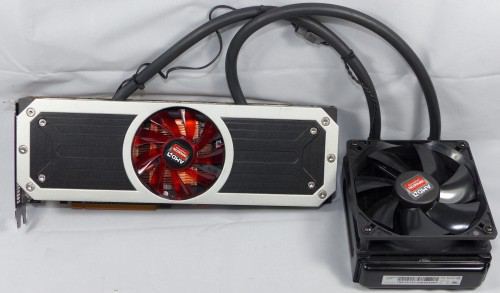
Here is the beast! The card was delivered to me without box so there will be no unboxing today! AMD offers here a massive-looking card equipped with an AIO water cooling system as we find them everywhere now for processors, a 120mm kit to cool 2 x R9 290X seems a bit light to me, but we will see this point later! Let’s see the map in more detail.
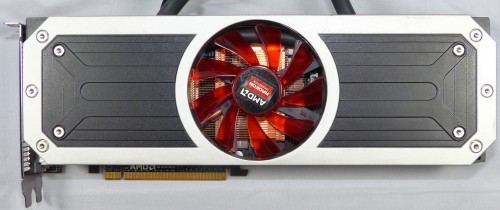
AMD has decided to radically change the look of its card, here more plastic but an all-metal fairing which gives an impression of solidity (and weight) foolproof! Stuck in the middle of the fairing a transparent red fan (which lights up once the card is on!) Positioned above a copper radiator used to cool the VRMs, the build quality is very good, the card is very clearly high of range.


The metal fairing is perforated above and below to facilitate the evacuation of the air, in addition to the water-cooling pipes above we can see the RADEON logo, which lights up once the card is on!
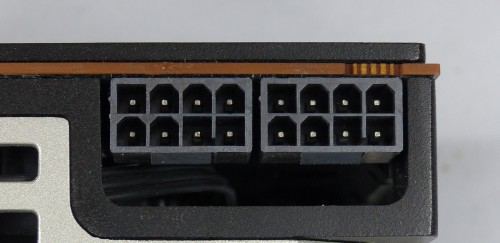
The power is of course entrusted to two 8-pin connectors, which seems to be a minimum here.
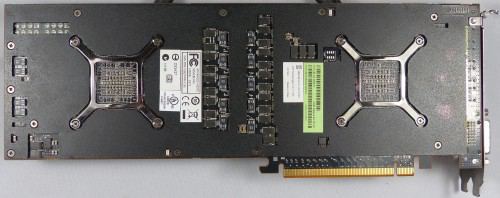
At the back the card is equipped with a black plate which will help to keep its rigidity, in addition to giving a better look to the whole. We can clearly see the positioning of the 2 GPUs here.
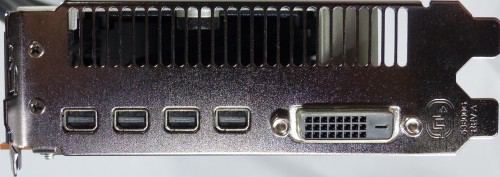
At the rear there are 4 mini-DP connectors as well as 1 DVI, a small grid is also present to evacuate a little of the heat released outside the box.
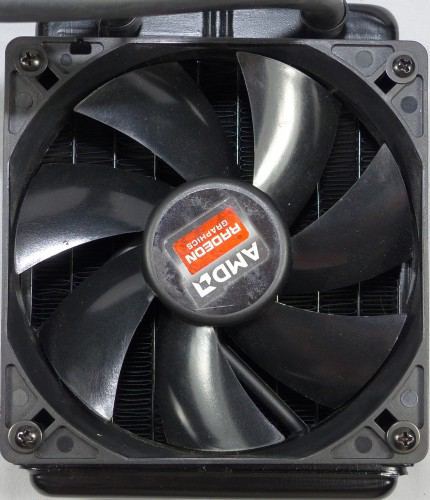
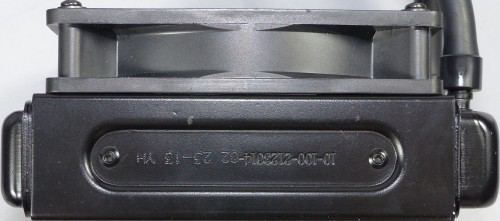
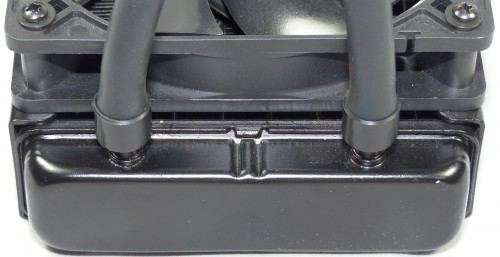
The external heat sink is identical to any other AIO CPU kit that can be found anywhere on the market now. It is equipped with a 12 cm black fan marked with the brand’s logo.
We undress the beast
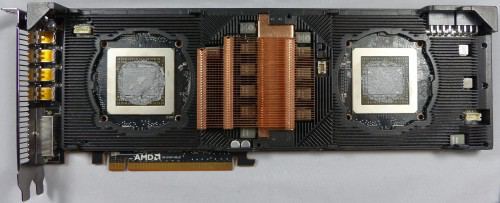
Once the fairing is removed, we fall on a thick metal plate which will greatly help the cooling of the components (memory for example), in addition to making the whole very rigid to avoid the slightest problem once installed in a case.
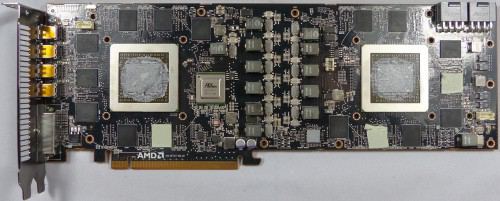
The beast is there completely naked, we can clearly see the 2 GPUs each equipped with their 4 GB of memory, the central part is reserved for VRMs (which heats the most!) And falls directly under the fan. We can also notice a PLX PEX8747 chip which will be the link between the 2 GPUs. Considering the architecture the card will act exactly like a physical 2 x R9 290X Crossfire.

The cooling system is left at 2 waterblocks with integrated pump, one for each GPU and linked together.
Powertune
With the evolution of Powertune there was a need for a little explanation of why and how, what is Powertune? AMD has introduced a control unit integrated into the GPU which allows certain things to be limited:
- The consumption of the card cannot exceed a certain consumption, which is not specified for the R9 295 X2 (but which is 208 Watts for the R9 290X)
- GPU temperature cannot exceed 75 °
In practice this means that regardless of your overclocking or the conditions of use of the card (very well ventilated case or not) the GPU will not exceed 75 °, to do this Powertune comes into play and will automatically reduce the frequency of the GPU. to satisfy this limitation.
Of course it is possible to override these directives by modifying the settings in Catalyst or any other overclocking software (such as iPower from HIS) of the “Board Power Limit”, going to a maximum of 50% more in terms of consumption. even though the maximum temperature still remains at 75 °, here is a screenshot from the AMD CCC:
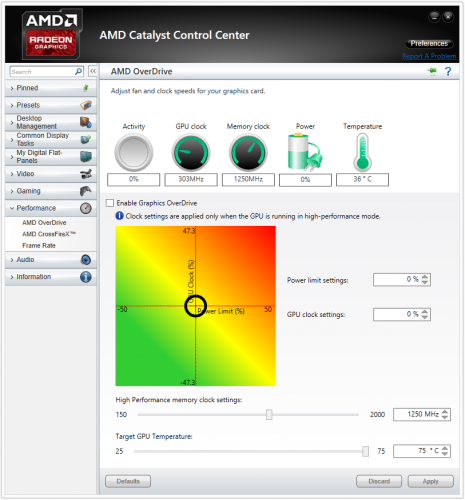
It is indeed possible to increase the limitation of consumption under CCC but, as we will see during the tests, the cooling system has great difficulty in containing the attacks of the 2 GPUs, so the temperatures very quickly reach 75 °, from the suddenly increase in consumption or not, this will not change the overall performance at all.
The test platform
The configuration used during the tests is as follows:
- Processor : Intel Core i7 5820K @ 4 Ghz
- Motherboard : Gigabyte X99 Gaming G1
- Memory : Corsair Vengeance LPX 4 x 4 GB 2666Mhz (tested here)
- SSD : Crucial MX200 250 GB (tested here)
- Food : be quiet! Dark Power Pro 850 (tested here)
- Drivers : Catalyst 15.7.1
- Operating system : Windows 8.1 64bits
All games will be tested in 1920 x 1080 and 2560 x 1440 detail in full detail (except the TressFX on Tomb Raider), which is the current ‘standard’, graphics cards used in testing are as follows:
- MSI R9 290 Gaming OC 4GB (tested here)
- Powercolor R9 280X (tested here)
- Sapphire 7950 Dualx @ 900Mhz
- Sapphire R9 280X VaporX Tri-X (tested here)
- XFX R9 280 Double Dissipation (tested here)
Consumption / Temperature
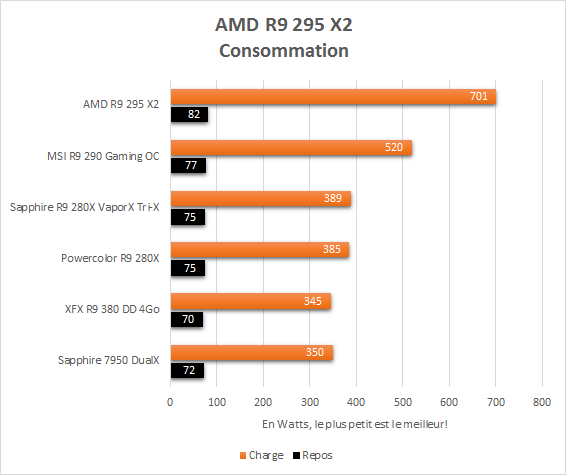
The consumption test was carried out under OCCT Power Supply which makes it possible to push the consumption of the components to the maximum, note that this value reflects the total consumption at the outlet of the machine and not the graphics card itself!
As we suspected, the consumption of the configuration with the R9 295 X2 installed greatly exceeds that of all the others, reaching a huge 701 Watts at the socket. It should still be remembered that we are facing 2 GPUs of R9 290X so there are no miracles possible! One thing is certain, you must have a power supply that holds up with a graphics card of this size, knowing that the 701 Watts at the outlet “draw” about 645 Watts on the power supply (taking into account the 80Plus Platinum output of the Dark Power Pro 11 850) a power supply of at least 750 Watts (quality) see 850 Watts will clearly not be oversized.
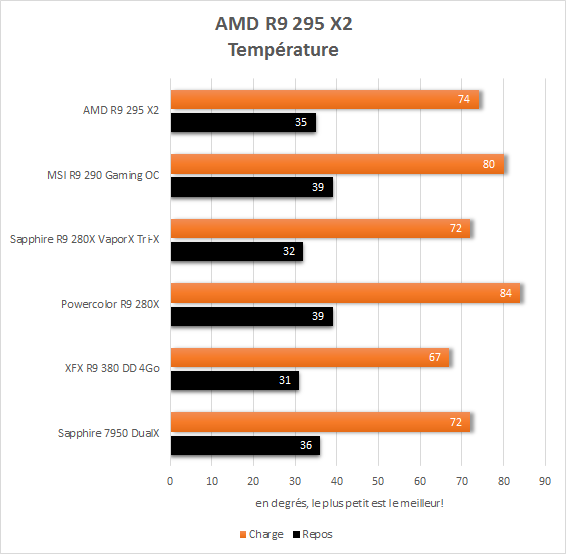
As I said above Powertune on the R9 295 X2 is set for a maximum of 75 ° on GPUs, unlike the 95 ° on the R9 290 / 290X, so we logically reach 74 °. The cooling system even if it keeps the GPUs at these temperatures would clearly have a lot of trouble if Powertune did not intervene, in fact the “simple” 12 cm radiator to cool such a monster does not allow a miracle.
Sound level
Warning: Part to be taken with a grain of salt, unfortunately not having access to the appropriate equipment and using an android application to take the readings the measurements below are only indicative! The readings were taken 20cm from the graphics card.
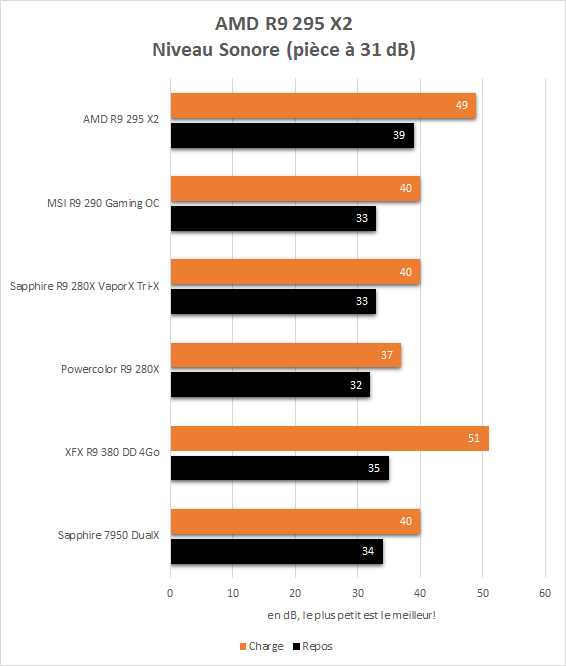
Noise level here too given the consumption and therefore the high heat release of the cattle, the fans of the “small” 12 cm radiator as well as that of the VRMs are clearly heard. At rest, unfortunately, with its 39 dB readings, the card is clearly not silent but it remains acceptable in a closed case, even if quite honestly it could have been much better. On the other hand, the card is not really discreet with 49 dB, but once again we are dealing with a very greedy bi-GPU card, so no miracle.
Powertune
To start, let’s take a look at the Powertune that powers the R9 295 X2. Powertune is responsible for maintaining the temperature of the processor, the consumption of the card below certain values. During overclocking it is mandatory to be able to modify all the possible settings in order to get the best performance, for Powertune and the R9 295 X2 it is possible to increase the consumption limit of the card by 50% (like the R9 290 / 290X).
Let’s see how the GPU reacts when subjected to OCCT:
Factory settings :
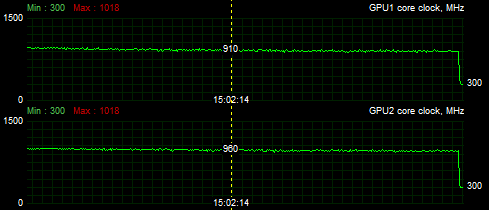
Under OCCT the card does not manage to keep its original frequencies of 1018 MHz, nothing surprising that said, this is the case for many graphics cards when they are pushed to the limit in stress tests (which is not is not representative of an in-game use). We note that GPU 2 has less trouble than GPU 1 with on average a higher frequency of 50 MHz, nothing that really changes the situation.
Consumption limit + 50% :
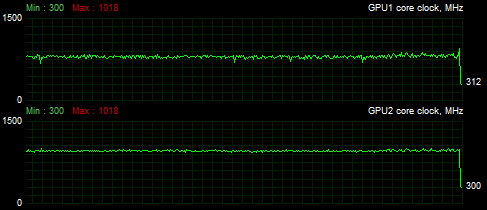
With the limitation of consumption unlocked there again the results are identical with a GPU1 oscillating around 900 MHz and a GPU2 around 950 MHz, the observation is simple, the limiting thing here is the temperature of the GPUs which reaches 74/75 ° and so Powertune intervenes.
What about when the card is subjected to something more representative of what might be asked for in a game, such as during a small 3DMark Fire Stike?
3DMark Fire Strike, factory settings :
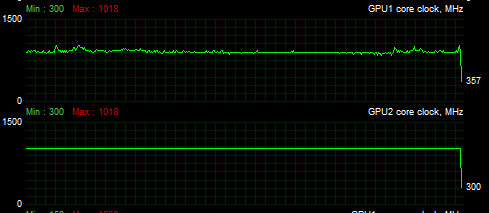
There the result is quite different, indeed the GPU2 manages to keep its 1018 MHz constant throughout the benchmark, on the other hand as under OCCT Powertune knocks on the door of GPU1 by making it lower its frequency to around 900 MHz, again a times the temperature reaching 74/75 ° is the problem here. Let’s see what happens with the consumption limit increased by 50%, although there is no hope for any change:
3DMark Fire Strike, consumption limit + 50% :

Indeed, the increase in consumption does not change anything, logical you will tell me given that the basic temperature was already blocking, more consumption will inevitably lead to more heat to be released, and that was already a concern.
To summarize, we can definitely say that the cooling system is the blocking factor here of the R9 295 X2, indeed to be able to maintain the original frequencies throughout the tests it would be necessary either to have a larger radiator, or much more ventilation, or another radiator interposed between the 2 GPUs. Why an interposed radiator you will tell me? The reason is simple, GPU 2 being the first cooled by the circuit it is naturally a little better cooled, suddenly the waterblock of GPU 1 inherits the heat of GPU 2 and sees its temperatures logically higher, Powertune therefore comes into play. faster on GPU 1 and lower its frequencies when 74/75 ° is reached.
Seeing the results here overclocking is clearly out of the question, it would be completely useless in the state to overclock the card since it is already struggling to keep the original frequency on the 2 GPUs, it would be good to say that it was possible to overclock it by 100 MHz if in the end this frequency is never reached except in a screenshot of GPU-Z 😉
3DMark Fire Strike

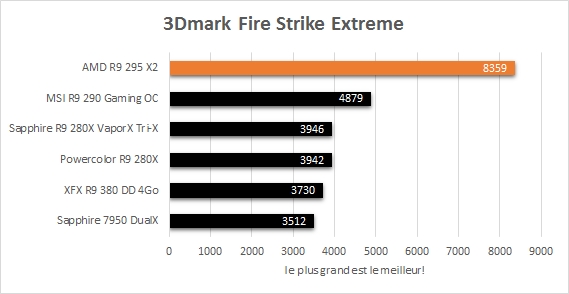
Battlefield 4
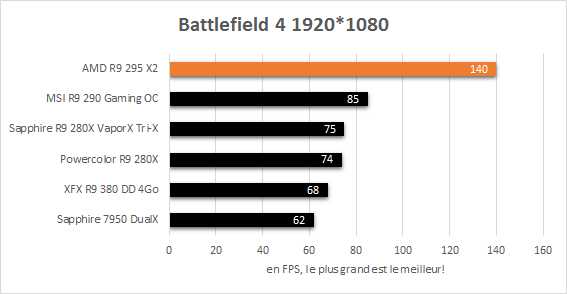

Bioshock Infinite
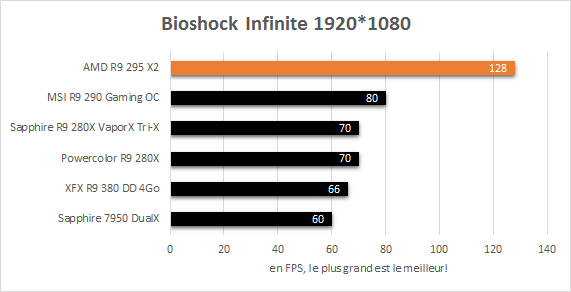
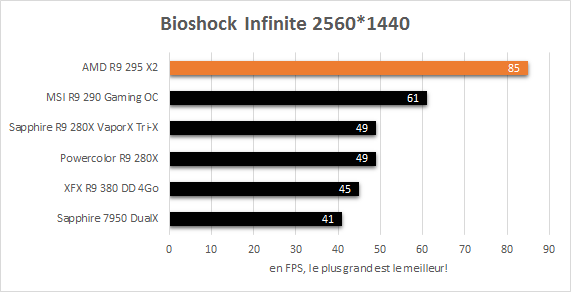
Crysis 3
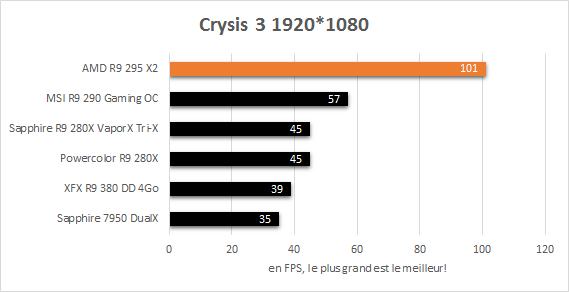
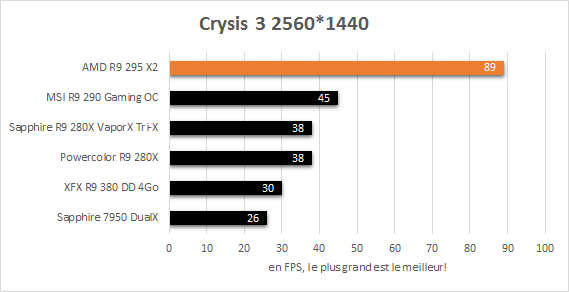
Hitman Absolution
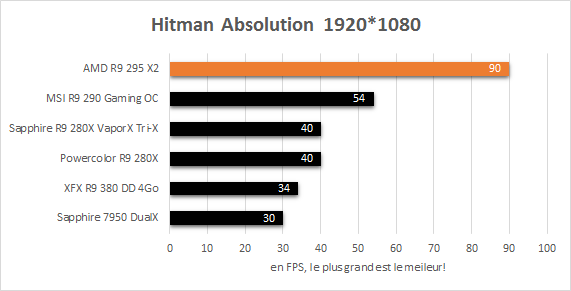
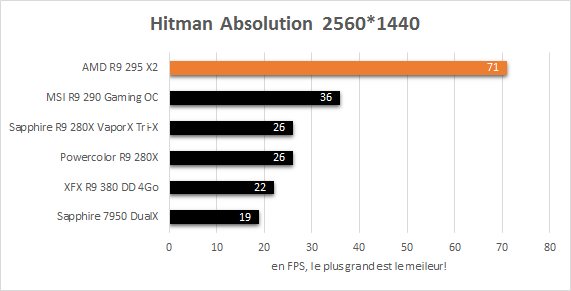
tomb Raider
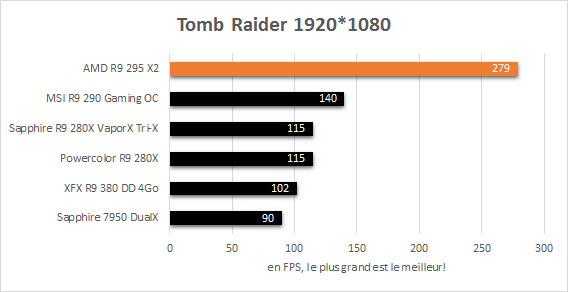
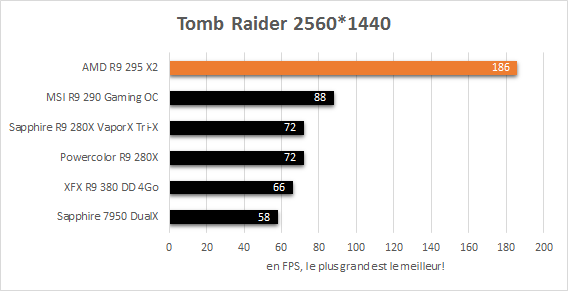
Summary of performance

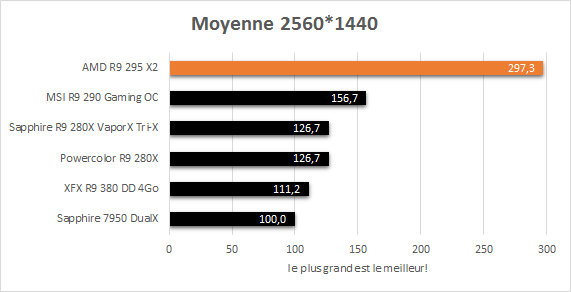
Performance is compared to a Sapphire HD7950 DualX, which has a 100 base
As we can see in the different games the performance of the R9 295 X2 is really excellent, the Crossfire is really well managed and we are ultimately at the level of 2 MSI R9 290 Gaming OC. All the games tested without exception take full advantage of the 2 GPUs of the R9 295 X2 and I did not notice any crashes or problems whatsoever during all the sessions made.
It goes without saying that a card like this remains a real monster even today and allows all games to run smoothly, even with its relative “old age”.
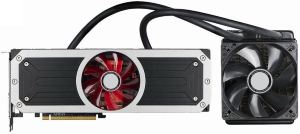
Here we are at the end of this test, what about the AMD R9 295 X2?
The R9 295 X2 is now a year and a half old and benefits from well-developed drivers, and it shows in games that take full advantage of them. The build quality is really excellent and the card benefits from a high-end finish, we feel that AMD has worked to make it a card made to last.
This is a technological showcase which does not however go without its flaws, indeed the really very high consumption (but we are talking here about a bi-GPU so nothing new) goes with a cooling system which is logically noisy and a Powertune which must also slow down the ardor of the beast by lowering the frequency during heavy loads to keep the correct temperatures.
In the end, if performance is the only thing that interests you and a 2-card Crossfire is not possible then the R9 295 X2 remains a card that clearly has it in the belly, but to take maximum advantage of it. A resolution of at least 2560 x 1440 will be recommended, below that there are other graphics cards that will do the job just fine while being much cheaper.
The +
- bi-GPU
- Performances
- Build quality
The –
- Consumption
- Noise















